What to do if the potato bursts and cracks in the ground, why does this happen
Sometimes, when harvesting, gardeners notice that individual potato tubers are deformed and look unattractive. There are many reasons for this phenomenon - from non-compliance with the conditions of agricultural technology to crop diseases. Let's take a closer look at why potatoes burst in the ground and whether it is possible to save the crop in such a situation.
The content of the article
Why do potatoes crack or burst in the ground
Many reasons contribute to the appearance of cracks in potato tubers: the results of diseases or attacks insect pests, violation of agricultural practices, the influence of weather conditions.
Potatoes that have cracked in the ground can contaminate the entire crop when stored.
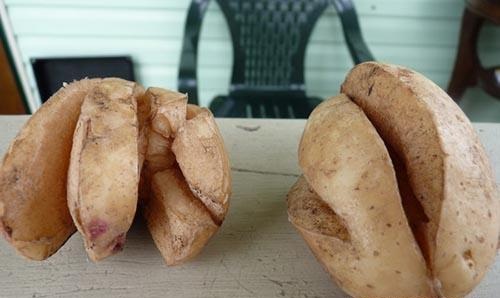
A sharp change in temperature
One of the main reasons for the formation of cracks in tubers is often unfavorable weather during the formation of the underground part of the vegetable.
The abrupt transition from drought to lingering rains and coolness increases the liquid content of potatoes. Because of this, the cells of the pulp begin to grow more actively, in contrast to the peel, which cannot withstand pressure and burst. Later, the site of injury is overgrown, forming defects in the form of cracks.
Poor planting material
The tuber culture is prone to rapid degeneration. Each subsequent harvest, in the absence of an annual change of sowing material, is increasingly exposed to infection with pathogens.
In potatoes, the shape of the tubers changes, the skin deteriorates, and the yield decreases. As a result, low-quality planting material becomes prone to cracking.
Violation of agricultural technology
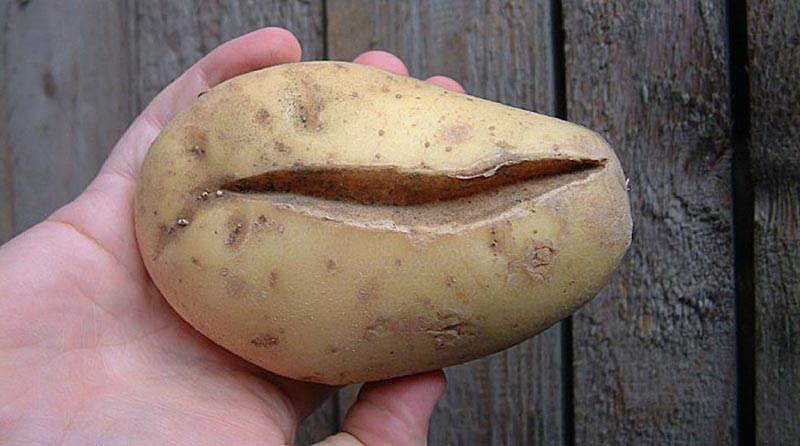
To preserve the qualities of the culture, it is important to comply with all the requirements of agricultural technology.
The reason that the potatoes crack in the ground is non-compliance:
- light mode;
- watering regime;
- landing dates;
- wrong choice of soil type.
If the planting material was introduced into the soil before it warmed up to + 8 ° C, the green mass of plants will stop developing and there will be no harvest.
Diseases
Potato diseases are different: some affect only the underground part, while others adversely affect the tops and tubers. If you do not take care of prevention in a timely manner, the crop is threatened with cracking.
Attention! Some types of pathogens are in the ground for several years and only when favorable conditions begin to actively multiply, affecting the culture.
Diseasescausing deformation of potatoes:
- fungal (scab, late blight);
- bacterial (ring rot, blackleg);
- viral (mottling, wrinkled mosaic, curling).
Diseases are often introduced to the site along with infected planting material.
There are non-parasitic problems. As a rule, they arise under the influence of unfavorable physicochemical conditions of cultivation. These include:
- lack or excess of nutrients;
- mechanical damage.
Pests
Dark spots, rotting pulp, cracked and deformed peel on tubers are a consequence of vital activity nematodesliving in the ground and parasitizing on potatoes. It is impossible to detect the pest, and signs of its presence appear only when the infection reaches its maximum.
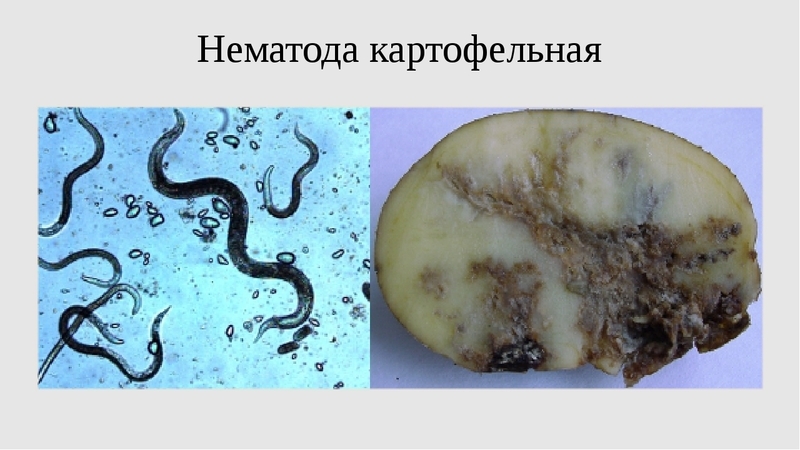
Another source of tubers cracking is wireworms, which also affect the flesh of the potato, leaving thin passages inside it. Bears can make the peel burst and deteriorate. They, bumping into culture, gnaw through the core, thus paving the way in it.
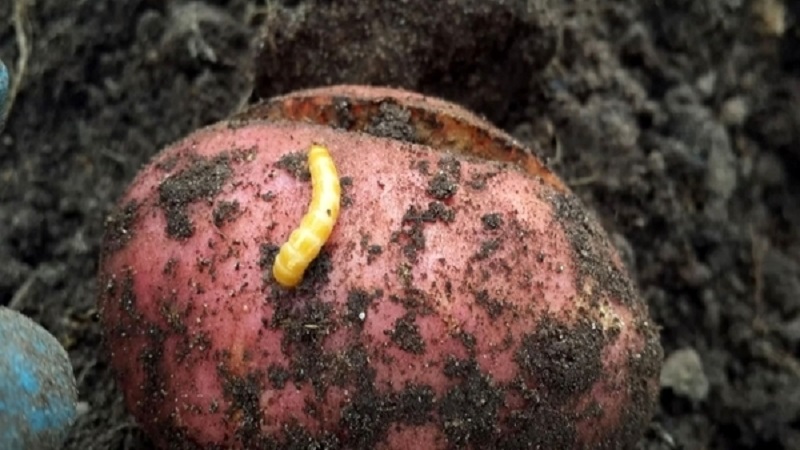
Unsuitable or clayey soil
The formation of correct potatoes is influenced by the ability of the soil to pass water and air.
Heavy clays and loams retain high humidity for a long time, but they have little oxygen. This leads to the fact that the roots of the plant do not receive enough nutrients, and the tubers, because of this, lose their standard shape, burst and crack.
Important! The culture develops well in sandy loam, loose and light soils.
Sandy soils lose water very quickly, which is not the best effect on potatoes, which will not grow well under such conditions.
Wrong watering regime
The surest way to spoil the future harvest is to wrong it to water.
Failure to comply with the irrigation regime in dry weather conditions leads to cracking and rotting of tubers. The uneven flow of liquid into the soil contributes to the improper formation of potatoes.
The negative effect on the quality of the crop is enhanced if the liquid in the ground accumulates faster than it disappears. Most often, the wrong watering regime becomes the cause of cracking of early potatoes.
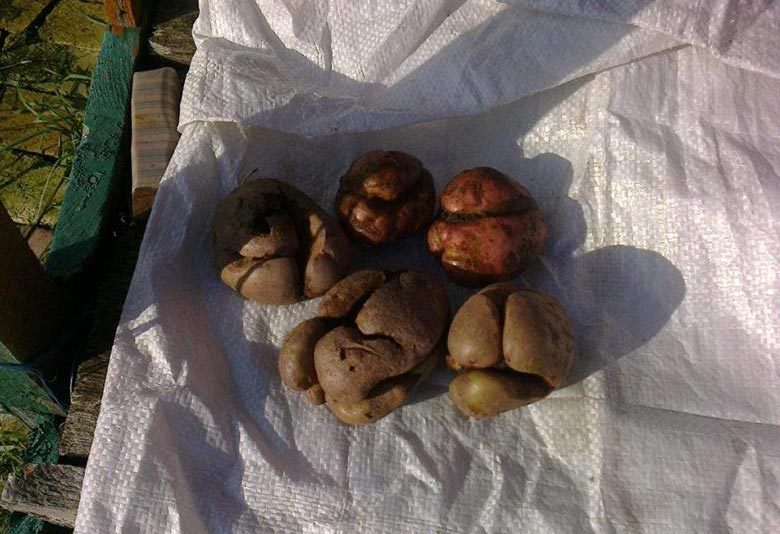
Methods for removing factors that negatively affect potatoes
The prevention of tubers cracking is effective only with an integrated approach. Selective application of recommendations in practice will not help remove factors that negatively affect culture.
The development of agricultural technology together with the suppression of the vital activity of pathogens and pests contributes to obtaining a high-quality result in prevention.
If it becomes known about soil contamination even before the potato planting begins, it is better to assign a quarantine status to the site. The crops harvested on such land are not transported or sold. The potatoes themselves are not grown in this place until 3 years.
How to prevent cracked potatoes
It is quite possible to prevent improper growth and deformation of tubers.
To do this, it is required to observe a set of preventive measures associated with proper cultivation techniques, to prevent the occurrence of diseases and pests.
Correct cultivation technique
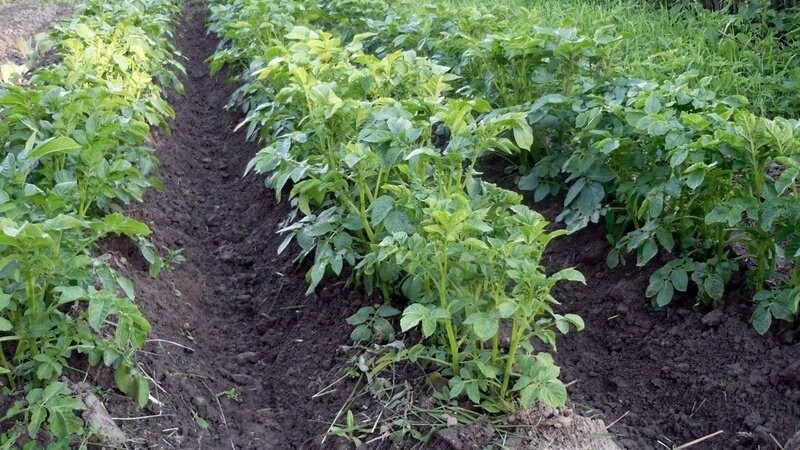
The following activities will help to obtain high yield rates, protect the crop from pathogens and insects:
- Careful selection of planting material. The most resistant to cracking will be potatoes grown from varieties that are immune to pests and diseases. Tubers should be no less than a chicken egg, without signs of infection and deformation.
- Compliance with crop rotation, which consists in alternation with other crops.
- Planting a barrage of vegetables. This prevents the migration of pathogens.
- Selection and preparation of suitable soil. To do this, they dig up the earth, bring in rotted sawdust and coarse sand (one 10-liter bucket per 1 m2), reduce acidity with ash, chalk or lime, plant green manure after harvest.
- Compliance with the irrigation regime. In hot summer conditions, humidification is carried out up to 2 times a week. The culture becomes especially sensitive to moisture during the period of growing vegetative mass. After the formation of tubers, the intensity of watering is reduced.
Loosening the soil, removing weeds and feeding potatoes are also included in the list of agricultural activities.
Fighting disease
Potato skins are home to infectious agents that are often inactive throughout the winter.
Therefore, before planting, the tubers must be pickled with fungicides:
- "Fitosporin";
- Kolfugo Super;
- "Fenoram Super";
- "Vitaros";
- "Mancozebom";
- "Maxim";
- "Vista";
- "Baktofit".
Spraying the planting material with Bordeaux liquid (100 g of copper sulphate and 150 g of quicklime per 10 liters of water) or a solution of copper (1 tablespoon of powder per 1 liter of water) will save you from fungal diseases.
Pest control
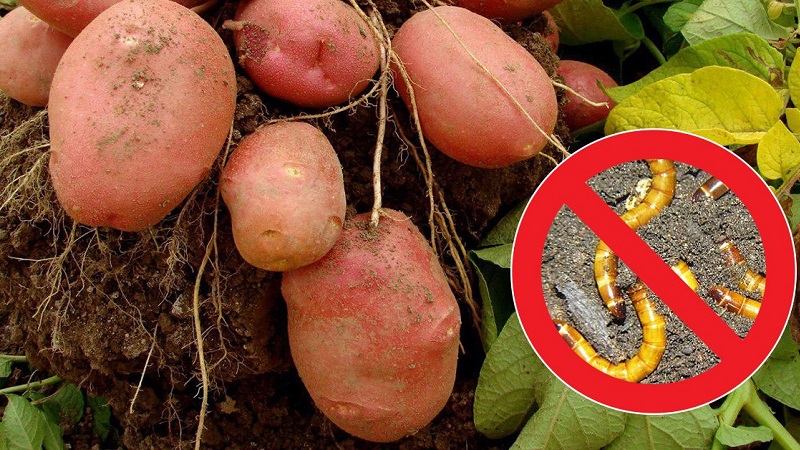
To destroy pests that can lead to cracking of the tubers, they begin before introducing the planting material into the soil.
Treatment with drugs will help get rid of nematodes:
- "Nemagonom";
- "Phosphamide";
- "Carbation";
- "Bazudin".
Store chemicals "Aktofit" or "Entocid" will prevent the reproduction of the bear and wireworm.
Important! Enriching the soil with earthworms and replacing cow manure with bird manure will help in the fight against insect pests.
Plants with an insect repellent smell are planted next to the potatoes: garlic, coriander, marigolds and chrysanthemums.
Additional recommendations
In addition to the standard ways to deal with the problem, there are a number of additional tips that will help protect the tubers from cracking:
- Bringing the seed into a state of uniform greening of the skin.
- Selecting a well-lit area.
- Three-fold hilling: with tops of up to 10 cm, 2 weeks after the first and before blooming on the green mass.
- Correct watering. If weather forecasters do not predict a dry summer, 2 waterings will be enough for the bushes for the season (a week after emergence and at the beginning of tuber formation).
- Loosening the soil after wetting.
- Providing drainage in case of regular heavy rainfall.
- Timely weed harvesting.
- With a small plot size, the alternation is not of crops, but of potato varieties with different ripening periods.
- Cleaning and destruction of diseased bushes, up to burning.
- Autumn deep digging of soil and planting green manure.
What to do with cracked and burst potatoes
There are many claims that it is pointless to store deformed potatoes: not only will it not last long, but it will also be dangerous for healthy crops in the cellar.
Experience has shown that cracked or burst tubers can be stored well in dry rooms and are still usable.
Is it possible to eat and save this
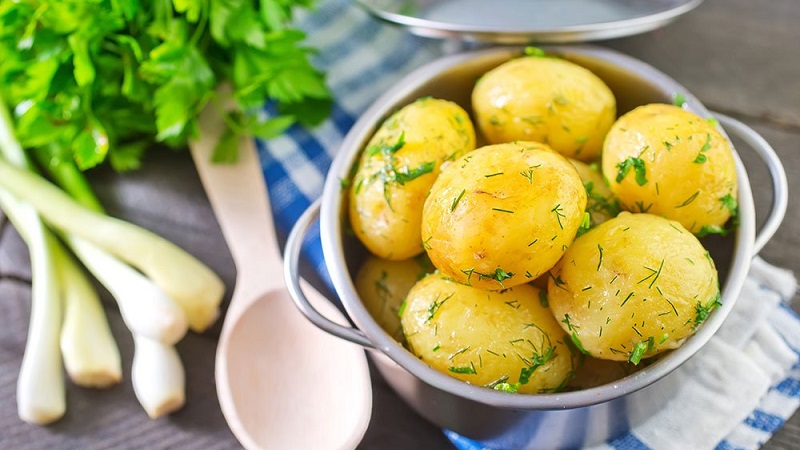
Cracked potatoes without signs of rot or disease can be safely consumed, but first of all. Appearance does not affect taste in any way.
Important!Cracked tubers are used for feeding pets, but never used for planting.
To reduce the risk of contamination of the rest of the crop, the cellar is cleaned, whitewashed and disinfected before laying. Deformed specimens are kept separately. For greater safety, burst potatoes are treated with Alirin-B or Gamair.
Conclusion
The problem of cracking and deformation of potatoes is completely solvable. They approach its elimination in a comprehensive manner: they follow the rules of agricultural technology, monitor the condition of the soil and the level of moisture, prevent infection and spread of insect pests on the site.
Damaged specimens are stored in a clean, dry cellar separately from the rest of the crop, used for food in the first place.